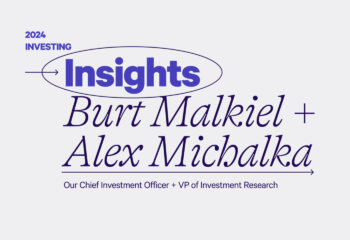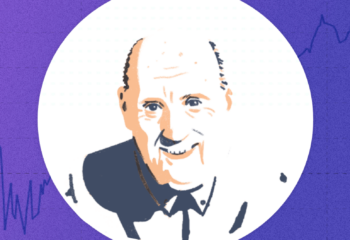It’s no wonder some people are inclined to stop investing when the market gets uncertain. So what’s our advice for worried or anxious investors? The same as always: Do nothing.
A version of this article was first published on April 7, 2018.
We get it: The stock market gyrations over the last few months have created a lot of unrest. After a rip-roaring January, there have since been some crazy swings up and down. The Dow lost 500 or more points in a single trading session five times, plummeting by more than 1,000 points two of those times. Not to mention, the S&P 500 index closed 10% or more below its late January peak, not once, but twice.
The good news is we’re seeing more of our clients staying focused on the long-term and not letting emotions take over amid dramatic market fluctuations. But with trade war fears, concerns about inflation or rising interest rates, and debate around tech sector regulation, it’s no wonder that some of our clients are inclined to stop investing. While there’s a lot of speculation, the reality is we just don’t know what’s ahead. But what we do know is that these are familiar market patterns we can learn from. So what’s our advice for worried or anxious investors? The same as always: Do nothing.
What History Teaches Us
If there’s anything the day-by-day machinations of the market teach us, it’s that slow and steady wins the race. Investors have long known that staying the course is one of the most important things to do — it’s just emotionally hard to execute. Some of the best research on this topic comes from the so-called “Wizard of Wharton”, University of Pennsylvania professor Jeremy Siegel. In his New York Times best-selling book, Stocks for the Long Run, Siegel looked at the performance of equities from 1802 through 1997, the year the book was first published.
His findings were astonishing: Despite the day-to-day volatility that we all feel, the actual long-run returns of stocks are remarkably consistent.
Here’s how he summarized his findings:
Source: Jeremy Spiegel. “Total Return Index.” Stocks for the Long Run, 1994
“Despite extraordinary changes in the economic, social, and political environment over the past two centuries, stocks have yielded between 6.6 and 7.2 percent per year after inflation in all major subperiods. The wiggles on the stock return line represent the bull and bear markets that equities have suffered throughout history. The long-term perspective radically changes one’s view of the risk of stocks. The short-term fluctuations in market, which loom so large to investors, have little to do with the long-term accumulation of wealth.“
His last line bears repeating: The short-term fluctuations in market, which loom so large to investors, have little to do with the long-term accumulation of wealth.
Siegel found that almost no matter what period you looked at, stocks delivered about 7% after inflation. The Civil War, World War I, World War II, even the Great Depression (marked by the second black vertical line) were hiccups compared to the overall trend.
The pattern repeats in other countries, including those that have experienced catastrophic collapses. World War II, for example, sheared 90% off the value of German equities…but German stocks completely rebounded by 1958, rising 30% per year on average from 1948 to 1960. They went on from there to new highs. Averaged out over the long haul, their return is a consistent 6.6% annual real return, a figure that continues through this day.
The same is true for Japan, the UK, and all other markets that Siegel has studied: in the short-run, volatility, but in the long run, profits.
Don’t Buy What They’re Selling
The reason we don’t hear much about the power of long-term investing – and the truth about the futility of trading – is that long-term investing is boring and cheap. The financial media thrives by encouraging you to panic, and large parts of the financial industry make money only when you act. Big moves sell newspapers, and high trading activity means commissions for online brokers.
The only people who don’t profit from that activity are investors themselves, because as it turns out, we can’t predict the future. It’s hard to stare down a significant market correction and stick to your plan.
When the US government shut down in September 2013 during the budget showdown, we saw a large number of our clients refrain from continuing to add deposits. The same was true during the Greek Crisis, Brexit, and the 2016 U.S. Presidential election. People who stayed on the sidelines paid handsomely for missing out on the rebound. As our research showed in There’s No Need to Fear Stock Market Corrections, markets on average recover from corrections in less than 90 days. Far faster than almost everyone thinks. If you invest regularly, harvest your losses, and rebalance your portfolio, you’ll end up benefiting from market corrections in multiple ways. It won’t be easy. But over the long haul, it can really pay off.
Disclosure
Wealthfront prepared this article for informational purposes and not as an offer, recommendation, or solicitation to buy or sell any security. Wealthfront and its affiliates may rely on information from various sources we believe to be reliable (including clients and other third parties), but cannot guarantee its accuracy or completeness. See our Full Disclosure for more important information.
Wealthfront and its affiliates do not provide tax advice and investors are encouraged to consult with their personal tax advisor. Financial advisory and planning services are only provided to investors who become clients by way of a written agreement. All investing involves risk, including the possible loss of money you invest. Past performance does not guarantee future performance.
About the author(s)
Andy Rachleff is Wealthfront's co-founder and Executive Chairman. He serves as a member of the board of trustees and chairman of the endowment investment committee for University of Pennsylvania and as a member of the faculty at Stanford Graduate School of Business, where he teaches courses on technology entrepreneurship. Prior to Wealthfront, Andy co-founded and was general partner of Benchmark Capital, where he was responsible for investing in a number of successful companies including Equinix, Juniper Networks, and Opsware. He also spent ten years as a general partner with Merrill, Pickard, Anderson & Eyre (MPAE). Andy earned his BS from University of Pennsylvania and his MBA from Stanford Graduate School of Business. View all posts by Andy Rachleff



